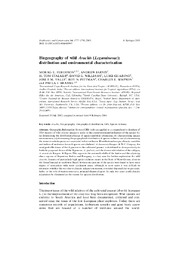Biogeography of wild Arachis (Leguminosae): distribution and environmental characterisation.
Biogeography of wild Arachis (Leguminosae): distribution and environmental characterisation.
Author(s): FERGUSON, M. E.; JARVIS, A.; STALKER, H. T.; WILLIAMS, D. E.; GUARINO, L.; VALLS, J. F. M.; PITTMAN, R. N.; SIMPSON, C. E.; BRAMEL, P. J.
Summary: Geographic Information System (GIS) tools are applied to a comprehensive database of 3514 records of wild Arachis species to assist in the conservation and utilisation of the species by: (a) determining the distributional range of species and their abundance; (b) characterising species environments; (c) determining the geographical distribution of species richness; and (d) determining the extent to which species are associated with river basins. Distributional ranges, climatic variables and indices of endemism for each species are tabulated. A. duranensis Krapov. & W.C. Gregory, the most probable donor of the A genome to the cultivated peanut, is distributed in close proximity to both the proposed donor of the B genome, A. ipaënsis, and the closest wild relative of the cultigen, A. monticola Krapov. & Rigoni. This region in the eastern foothills of the Andes and the adjoining chaco regions of Argentina, Bolivia and Paraguay, is a key area for further exploration for wild Arachis. An area of particularly high species richness occurs in the State of Mato Grosso, close to the Gran Pantanal in southwest Brazil. Seventy-one percent of the species were found to have some degree of association with water catchment areas, although in most cases it was difficult to determine whether this was due to climatic adaptation reasons, restricted dispersal due to geocarpic habit, or the role of watercourses as a principal dispersal agent. In only two cases could climatic adaptation be eliminated as the reason for species distribution.
Publication year: 2005
Types of publication: Journal article
Observation
Some of Embrapa's publications are published as ePub files. To read them, use or download one of the following free software options to your computer or mobile device. Android: Google Play Books; IOS: iBooks; Windows and Linux: Calibre.
Access other publications
Access the Agricultural Research Database (BDPA) to consult Embrapa's full library collection and records.
Visit Embrapa Bookstore to purchase books and other publications sold by Embrapa.

